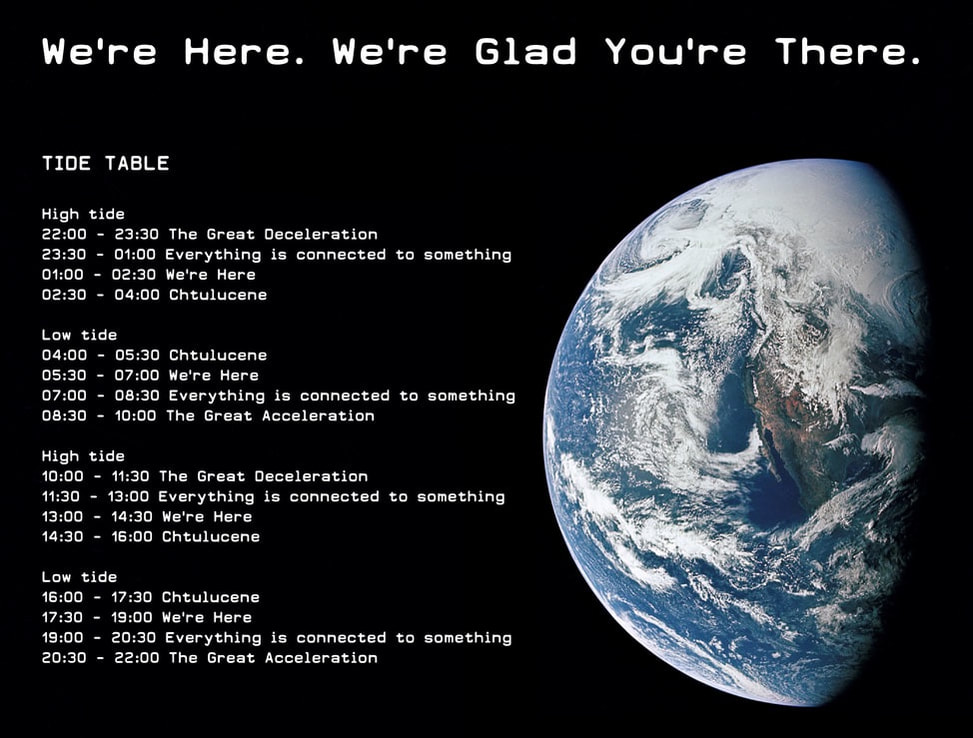We're here. We're glad you're there.
|
24 hours of live radio-music by Zwerm SLOW festival, 23-24/02/2019, Concertgebouw Brugge We're Here. We're Glad You're There. is a production of Zwerm, co-produced by Concertgebouw Brugge and in collaboration with Villa Bota. Concept & development: Kobe Van Cauwenberghe Live music: ZWERM. Photo: NASA. Thanks to Villa Bota |
"I believe that people in media have an important obligation to fulfil. That is to truly grasp the spirit of the period. And at the same time to use their imaginative powers and practical skills to create a ‘dream tide'."
H. Yokoi *
"It is time for a chtonic swarm."
D. Haraway **
In "We’re here. We’re glad you’re there." Zwerm will use the medium of FM-radio to create a 4 part cycle of 24 hours of live radio music. Inspired by Hiroshi Yokoi’s 24 hour ambient radio broadcasts in Japan in the early 90’s, the program is structured according to Yokoi’s ‘tide of sound’ method following the tide’s cyclical pattern by which Zwerm aims to slow down and generate a musical 'dream-tide'. The musical content will be generated by a backing track running on a reel-to-reel tape recorder, which functions both as a score for the musicians to play along with, as well as a metaphorical clock:
Depending on the tide, a cycle ends or starts in what Donna Haraway describes as the Chtulucene, which is “a name for an elsewhere and elsewhen that was, still is, and might yet be.” The Chtulucene is what comes just before and right after the tape runs out, the “tipping point”. It is the “aftermath” as well as a new beginning. “Think we must; we must think. That means, simply, we must change the story; the story must change.”
We’re here. The sound of the deepest part of the ocean, an iceberg, a forrest, a swarm of cicadas, the sound of a city, of late capitalism, a corporate coffee shop at rush hour, a protest march.
But nothing changes: there is a sound of a continuous drone, the sound of stability. This stasis is comforting, but it is only apparent and misleads us. It is extremely fragile, every little detail can make irreversible changes. “Nothing is connected to everything, but everything is connected to something.”
Irreversible changes will lead to what has come to be known as The Great Acceleration. But also here the end can be a new beginning. “The world is not finished and the sky has not fallen—yet. We are at stake to each other.”
* Toop, David. ‘Ocean of Sound’, London, Serpents Tail, 1995, pp. 154.
** All remaining text in italic are quotes from Donna Haraway’s essay ‘Staying With The Trouble, Anthropocene, Capitalocene, Chtulucene’, in Moore, Jason W. (ed.), Anthropocene or Capitalocene? Nature, History and the Crisis of Capitalism, Oakland, PM Press, 2016, pp. 34-76.
H. Yokoi *
"It is time for a chtonic swarm."
D. Haraway **
In "We’re here. We’re glad you’re there." Zwerm will use the medium of FM-radio to create a 4 part cycle of 24 hours of live radio music. Inspired by Hiroshi Yokoi’s 24 hour ambient radio broadcasts in Japan in the early 90’s, the program is structured according to Yokoi’s ‘tide of sound’ method following the tide’s cyclical pattern by which Zwerm aims to slow down and generate a musical 'dream-tide'. The musical content will be generated by a backing track running on a reel-to-reel tape recorder, which functions both as a score for the musicians to play along with, as well as a metaphorical clock:
Depending on the tide, a cycle ends or starts in what Donna Haraway describes as the Chtulucene, which is “a name for an elsewhere and elsewhen that was, still is, and might yet be.” The Chtulucene is what comes just before and right after the tape runs out, the “tipping point”. It is the “aftermath” as well as a new beginning. “Think we must; we must think. That means, simply, we must change the story; the story must change.”
We’re here. The sound of the deepest part of the ocean, an iceberg, a forrest, a swarm of cicadas, the sound of a city, of late capitalism, a corporate coffee shop at rush hour, a protest march.
But nothing changes: there is a sound of a continuous drone, the sound of stability. This stasis is comforting, but it is only apparent and misleads us. It is extremely fragile, every little detail can make irreversible changes. “Nothing is connected to everything, but everything is connected to something.”
Irreversible changes will lead to what has come to be known as The Great Acceleration. But also here the end can be a new beginning. “The world is not finished and the sky has not fallen—yet. We are at stake to each other.”
* Toop, David. ‘Ocean of Sound’, London, Serpents Tail, 1995, pp. 154.
** All remaining text in italic are quotes from Donna Haraway’s essay ‘Staying With The Trouble, Anthropocene, Capitalocene, Chtulucene’, in Moore, Jason W. (ed.), Anthropocene or Capitalocene? Nature, History and the Crisis of Capitalism, Oakland, PM Press, 2016, pp. 34-76.









